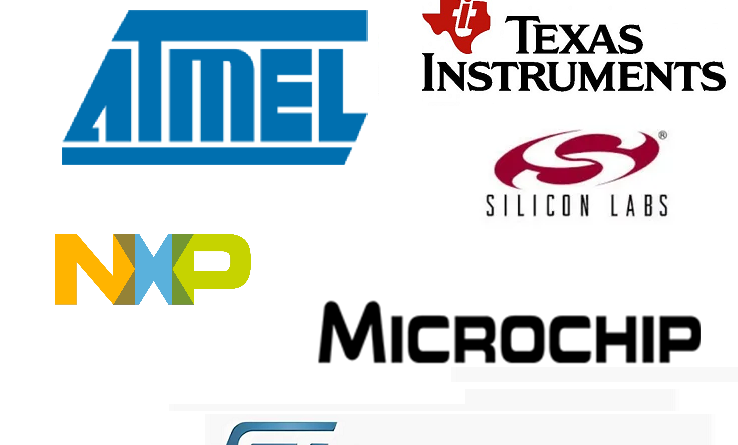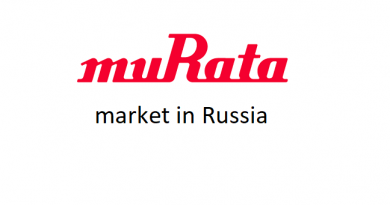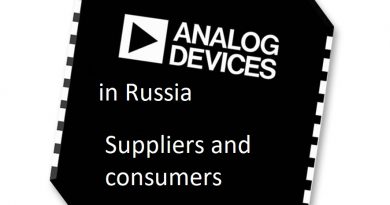Microcontroller market in Russia. The past and the present.
Part 1. 1976-2010
5 years after the appearance of the first microprocessor, in 1976, the first microcontroller was created. It was an Intel 8048 chip.
Created in 1972, the 4-bit TMS1000 by Texas Instruments contained RAM (32 bytes), ROM (1K), a clock, and I / O support, could also be considered the first microcontrollers due to its characteristics. Also, they had the ability to add new instructions.
Released in 1980, the Intel 8051 microcontroller is a classic example of this class of devices. This 8-bit chip was the first of a family of microcontrollers that existed and was leading until recently.
The analogues of 8051 were produced in Minsk, Kiev, Voronezh, and Novosibirsk: the whole generation of domestic developers grew on this equipment.
In 1983, Texas Instruments released the TMS32010 digital signal processor, which outperformed its competitors and became the progenitor of an entire DSP dynasty.
Other prominent representatives of eight-bit microcontrollers were Motorola products (68HC05, 68HC08, 68HC11) and microcontrollers by Zilog which was founded by former Intel employees (Z8).
After the advent of Microchip’s PIC controllers, global change has come. They quickly captured a significant part of the microcontroller market due to their unbelievably low cost. In addition, the crystals from Microchip were not inferior, and often surpassed the x51 microcontrollers in performance, and did not require an expensive programmer.
In 1993, the first Atmel microcontroller was created based on the classic Intel 8051 microcontroller core. And in 1996, Atmel Corporation introduced its chip family on the new progressive core AVR, which raised the revolution and turned the whole world of microcontrollers upside down. More thought-out AVR architecture, performance superior to Microchip controllers, attractive pricing policy – all these factors contributed to the involvement of many developers.
In 1999, TexasInstruments’ remarkable family of 16-bit MSP430 microcontrollers entered the market. The company’s engineers were inspired by legendary DEC command system and computer architecture PDP-11 during the development of microcontrollers.
In 1999, the Cygnal company was formed, which later made a real breakthrough by equipping the microcontrollers with the advanced CIP-51 core. The upgraded CIP-51 core executed 70% of the instructions in one or two machine cycles, and generally does not have instructions that run in more than eight machine cycles. In microcontrollers with standard architecture 8051, all instructions, except for MUL and DIV, were executed in 12 or 24 machine cycles.
The 8-bit STM8 microcontrollers were released in 2008. They consumed little energy, had high performance, were inexpensive, and were available in a wide range of models.
A little earlier in 2004, Acorn developed the 32-bit ARM Cortex-M3 processor core, and ST Microelectronics was one of the first to introduce a family of microcontrollers on the core called STM32. It all started not so long ago – in 2007 with the advent of two families – “Performance Line” (STM32F103) and “Access Line” (STM32F101).
Not all companies have withstood competition in the market. At the end of 2003, MOTOROLA decided to finally “break” with the production of semiconductors, and the remaining SPS in 2004 was allocated to FREESCALE SEMICONDUCTOR. In 2006, FREESCALE SEMICONDUCTOR itself was bought by a consortium led by Blackstone Group LP, which at that time became the largest private purchase of a technology company and entered the top ten largest transactions in the world. In March 2015, NXP Semiconductors announced the acquisition of Freescale Semiconductor. The combination of NXP and Freescale into a single company created the fourth largest producer of processors and other complex microelectronics on the planet with a total asset value of $40 bln.
The following year, in January 2016, Microchip acquires Atmel for $ 3.56 billion.
In December 2003, Silicon Labs acquired Cygnal Integrated Products. In December 2009, IXYS Corporation purchased Zilog, and in August 2017, IXYS Corporation was acquired by Littelfuse Inc in exchange for $ 750 million in cash and shares.
How did all these new families of products, acquisitions and mergers affect the Russian market? At the end of 2010, according to statistics on requests to eFind.ru, in Russia, market leaders for microcontrollers were distributed as follows.
Table 1. The most highly demanded microcontroller manufacturers on eFind.ru
| 4 quarter of 2010, % | |
| Atmel | 51,4 |
| Microchip | 15,8 |
| NXP | 9,9 |
| STMicroelectronic | 7,6 |
| TexasInstruments | 7,4 |
| SiliconLabs | 2,9 |
| Freescale | 2,1 |
| AnalogDevices | 0,9 |
It is necessary to clarify once again that the table indicates the share of a specific manufacturer in Russia according to the search queries in the Internet. The information about Silicon Labs and Freescale might not be accurate, but the leadership of Atmel and Microchip in 2010 is undeniable.
Table 2. Queries for microcontrollers of different digit capacity.
| 4 quarter of 2010, % | |
| 8-bit | 59,7 |
| 32-bit | 18,1 |
| 16/32-bit | 10,4 |
| 16-bit | 8,1 |
| 8/16-bit | 3,3 |
Part 2. 2014 -2017: The competition is getting more serious.
Today, the microcontrollers the production of which is reduced or the service life ends, are manufactured using technology with 0.5-micron design standards, “mature” microcontroller microcircuits – according to 250- or 180-nm technology, relatively new products – according to 130- and 90-nm processes , the latest microcontrollers – with 65- and 55-nm standards. Design standards of the developed controllers are 40 nm or less.
At the same time, with the growing demand for microcircuits with smaller cell sizes, older technologies are “dying” due to the relatively high production costs. Despite this, in the microcontroller market you can find a wide assortment for different tasks. But, as you know, the appetite comes with food, and the requirements of the developers of embedded systems to the components are constantly increasing. Accordingly, new microcontrollers are constantly appearing on the market, the technical parameters of which are constantly growing due to the development of innovative technologies.
For example, an important trend in 2014 was the integration of a wireless device or module into the microcontroller chip.
By 2014, the struggle between 8- and 16-bit microcontrollers intensified. In the 2014 ranking of 8-bit microcontroller suppliers to the global market by analytic company Gartner, Microchip Technology again took the first place after it was replaced by Renesas Electronics in 2010, formed by the merger of business activity in the field of microcontrollers and microprocessors of three Japanese semiconductor giants – NEC, Hitachi and Mitsubishi.
In July 2015, Microchip reaffirmed its right to lead the 8-bit MK market with the release of two new PIC microcontroller families: PIC16F1887 7 and PIC16F1579 with advanced innovative core-independent peripherals (Core-Independent Peripherals, CIPs) and smart analog blocks, thanks to which the new microchips in functionality surpass the traditional 8-bit MK.
At the same time, Silicon Labs released a new family of 8-bit microcontrollers for super-energy-efficient, small-sized IoT applications in February 2015.
Silicon Labs, which was founded in 1996 by immigrants from CirrusLogic, broke into the world and the Russian market through the absorption of third-party companies, the development of its own technologies and maximum Russian-language support, which was carried out until the translation of datasheets into Russian, which no other had done before. company. Its share in requests for 2012 consistently was about 4%, which is a great achievement for such a young company.
The market with 32-bit microcontrollers also did not stand still. In 2015, Texas Instruments launched the new MSP432 family of microcontrollers, which continues the tradition of ultra-low power consumption built into the MSP430 and adds new computing power through the ARM Cortex-M4F architecture.
But, despite the innovations of 8-bit microcontrollers, the advantages of 32-bit were obvious for many products where significant computing resources were required. Of course, the struggle for the market between 32- and 8-bit microcontrollers is far from over. The balance between them has not yet been found. The developers realized that complex devices like 32-bit microcontrollers provide the necessary computing resources, rich peripherals and easy access to all kinds of design tools and libraries. Since 8-bit MKs of the latest generations provide the processor core with many high-speed peripherals, they become attractive for use in a variety of embedded projects. And, of course, today there are applications where the size and set of functions of 8-bit MKs determine their choice as opposed to 32-bit ones.
According to a 2015 report published by Gartner Research Company, sales of 8- and 32-bit devices in dollar terms were approximately equal. They amounted to $ 6 bln. Taking into account the difference in average prices, these figures indicate that in 2015 there were three 8-bit microcontrollers per embedded 32-bit microcontroller.
In 2016, the microcontroller market recorded a decline in revenue by 6% against the background of reduced supplies of these components. However, after the inventory of microcontrollers returned to normal levels, electronics manufacturers sharply increased MCU purchases in 2017. As a result, the supply of microcontrollers jumped by 22%, and revenue in the market increased from $15 to $16.8 bln.
The average selling price (ASP) of microcontrollers in 2017 fell to the lowest value in history and continued to decline in 2018.
IC Insights believes that prices will fall on the MCU in 2019-2022, but not as fast as in the past. The average annual reduction will be 3.5%, while from 2012 to 2017 prices fell by an average of 5.8%, and in the period from 1997 to 2017, microcontrollers became cheaper by an average of 6.3% in year.
According to IC Insights, in 2019, sales are expected to grow by another 9%, to $ 20.4 billion.
The IC Insights five-year forecast stipulates that the market volume in money will increase by an average of 7.2% and will reach $ 23.9 bln by 2022. The growth in unit terms is expected to reach 11.1%. By the end of the period under review, the supply of microcontrollers reached approximately 43.8 bln units.
Part 3. 2018. Russia.
Let’s check the eFind.ru search engine again. According to the statistics of requests for eFind.ru in Russia, at the end of 2018, the microcontroller market leaders in the Russian Federation were distributed as follows.
Table 3. The most highly demanded microcontroller manufacturers on eFind.ru
| 2010 | 2013 | 2015 | 2017 | 2018 | |
| IV Q | IV Q | IV Q | IV Q | IV Q | |
| MicrochipTechnology/Atmel | 67,2 | 49 | 45,9 | 40,8 | 41,6 |
| STMicroelectronics | 7,6 | 24,1 | 23,6 | 36,1 | 29,8 |
| TexasInstruments | 7,4 | 8,8 | 9,4 | 6,5 | 7,5 |
| NXP/Freescale | 12 | 10,5 | 9,3 | 5,6 | 7,1 |
| SiliconLabs | 2,9 | 4,3 | 3,8 | 3,1 | 3,2 |
| CypressSemiconductor | 0,7 | 0,7 | 2,1 | 1,2 | 2,6 |
| RenesasElectronics/NEC | 0,8 | 0,6 | 1,2 | 1,5 | 2 |
| AnalogDevices | 0,9 | 1,1 | 1,5 | 1,5 | 1,1 |
| InfineonTechnologies | 0,6 | 0,6 | 1 | 0,6 | 1,3 |
Microchip / Atmel continue sharing the first place in the list of popular manufacturers of microcontrollers in Russia, but their joint share (shown in table 3) continues to fall. The share of ST Microelectronics due to the earliest start of sales of ARM Cortex-M3 continues to increase. The author of the article participated in the first purchases of the ARM Cortex ST Microelectronics warehouse, and then the distributor company was ahead of its closest competitors by about six months. Many years later, the company remains the leader in sales for Cortex-XX, which indicates the importance of recognizing the novelty in time and starting a promotion company.
Table 4. The most popular core brands on eFind.
| 2010 | 2013 | 2015 | 2017 | 2018 | |
| IV Q | IV Q | IV Q | IV Q | IV Q | |
| AVR | 44,2 | 27,7 | 17,8 | 15,2 | 15,2 |
| PIC | 15,2 | 16,3 | 10,9 | 12,6 | 13,4 |
| ARMCortexM4 | 0 | 9,8 | 9,7 | 10,2 | 7,9 |
| ARMCortexM3 | 11,9 | 17,7 | 11 | 9,5 | 9 |
| 8051 | 9,6 | 8,8 | 6,4 | 5,9 | 7 |
| ARMCortexM0 | 0,5 | 5,4 | 6,2 | 6 | 4,9 |
| ARMCortexM7 | 0 | 0 | 1,6 | 5,5 | 3,8 |
| ARMCortexM0+ | 0 | 0 | 2,6 | 3,4 | 2,8 |
| MSP430 | 4,2 | 5,8 | 3,5 | 2,7 | 3,6 |
| STM8 | 0,3 | 3,3 | 2 | 2,8 | 2,8 |
In table 2, the demand for microcontrollers with different cores is compared.
Current changes:
- a huge drop in the share of requests for AVR;
- All shares of ARM Cortex have seriously grown. In total, from 12.4% to 28.4%;
- the share of PIC for the entire time of observation (since 2010 [1]) fell from 15 to 11%;
- ARM7 and ARM9 cores dropped out of the top 10.The data above are search queries in the search engine that reflect current status or future projects. Following the trend, it can be assumed that the share of the ARMCortex core in the variations will continue to increase due to the AVR core. Surprisingly, the reliable, high-quality, but still already outdated 8051 core continues to hold a significant share in the statistics. Perhaps some engineers continue to habitually evaluate the use of the core in current developments, or have a big impact on the repair market.
Since 2016, the Customs Service of the Russian Federation has been publishing publicly available information on merchandise exports and imports. First of all, this is done to combat the gray market. In the process of purchasing consignments of goods, buyers can verify the accuracy of the declaration: diodes, and not scrap metal, were brought into the country. As the result of this struggle, we can now independently evaluate market shares for various products.
Microcontrollers are most often exported to Russia by 8542319010 customs code. (INTEGRAL MONOLITHIC SCHEMES), this code still imports a huge number of crystals for smart cards or the cards.
Therefore, the analysis requires market knowledge, but after subtracting the data, we get the result in table 5.
Table 5. Import of microcontrollers to Russia by brand in 2018.
| Manufacturer | Cost $ | % | Weight (kg) |
| MICROCHIP/ ATMEL | 17610000 | 22,218 | 5733 |
| TEXAS INSTRUMENTS | 15117000 | 19,073 | 1590 |
| STMICROELECTRONICS | 13870000 | 17,5 | 2530 |
| NXP/ FREESCALE | 13707000 | 17,294 | 6554 |
| INFINEON TECHNOLOGIES | 8430000 | 10,636 | 2089,8 |
| ANALOG DEVICES INC | 7970000 | 10,056 | 573 |
| SILICON LABORATORIES INC. | 1520000 | 1,918 | 176 |
| CYPRESS SEMICONDUCTOR CORPORATION | 529000 | 0,667 | 109 |
| RENESAS ELECTRONICS CORPORATION | 506000 | 0,638 | 80 |
The four leaders are completely consistent with the statistics of eFind. Small differences in the amount are explained by the leadership of MICROCHIP / ATMEL in 8-bit, and STMICROELECTRONICS – in 32-bit microcontrollers. MICROCHIP / ATMEL in units of weight indicate that they sell many times more, but since the cost of 8-bit is much less than 32-bit, the difference in money is not as significant as in search queries. TEXAS INSTRUMENTS manufactures a wide range of digital signal processors, which also cost significantly more than 8-bit dischargers.
INFINEON stands out very much taking 5th place in money and the last on demand. But most of the brand’s sales come from a single distributor. There are 2 options here: the first – a few very large projects, the second – most of the INFINEON sales that are imported using this code fall on circuits that do not fall under the definition of microcontrollers, for example, smart cards.
Otherwise, the data from the search engine and customs are the same.
Recently, TEXAS INSTRUMENTS decided on the world revolution and deprived the status of distributor of all, literally everyone, except ARROW. The downward trend in the number of distributors has been, especially in semiconductors. Altera has one global distributor, Xilinx has one global distributor, AnalogDevices has one global distributor. But, to leave one and deprive all the regional … I must admit, I did not fully believe in this. Well, the more interesting it will be to track search queries and customs imports by TEXAS INSTRUMENTS, because many regional players will shift the point of application of effort. On the other hand, what is the loss for even TEXAS INSTRUMENTS even half of the business in Russia against the background of a possible increase in sales in the world? Time will show. The fight goes on.
- КОМПОНЕНТЫ И ТЕХНОЛОГИИ • No 7 ‘2012
Микроконтроллеры: статистика запросов на eFind.ru. Алексей СлАвгородСкий. - КОМПОНЕНТЫ И ТЕХНОЛОГИИ • No 7 ‘2019
Микроконтроллеры: статистика запросов на eFind.ru. Алексей СлАвгородСкий. - https://www.gartner.com/en
- http://www.icinsights.com/
- Таможенная статистика РФ
- https://myrobot.ru/stepbystep/mc_meet.php
- http://www.electronics.ru/journal/article/4828
- http://www.electrosnab.ru/files/silabs/articles/G2.pdf




